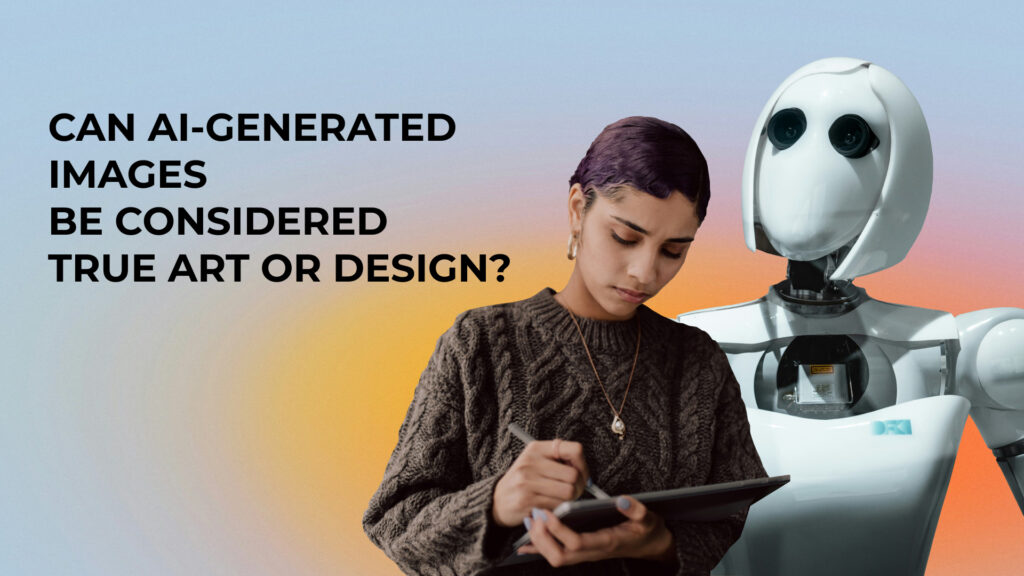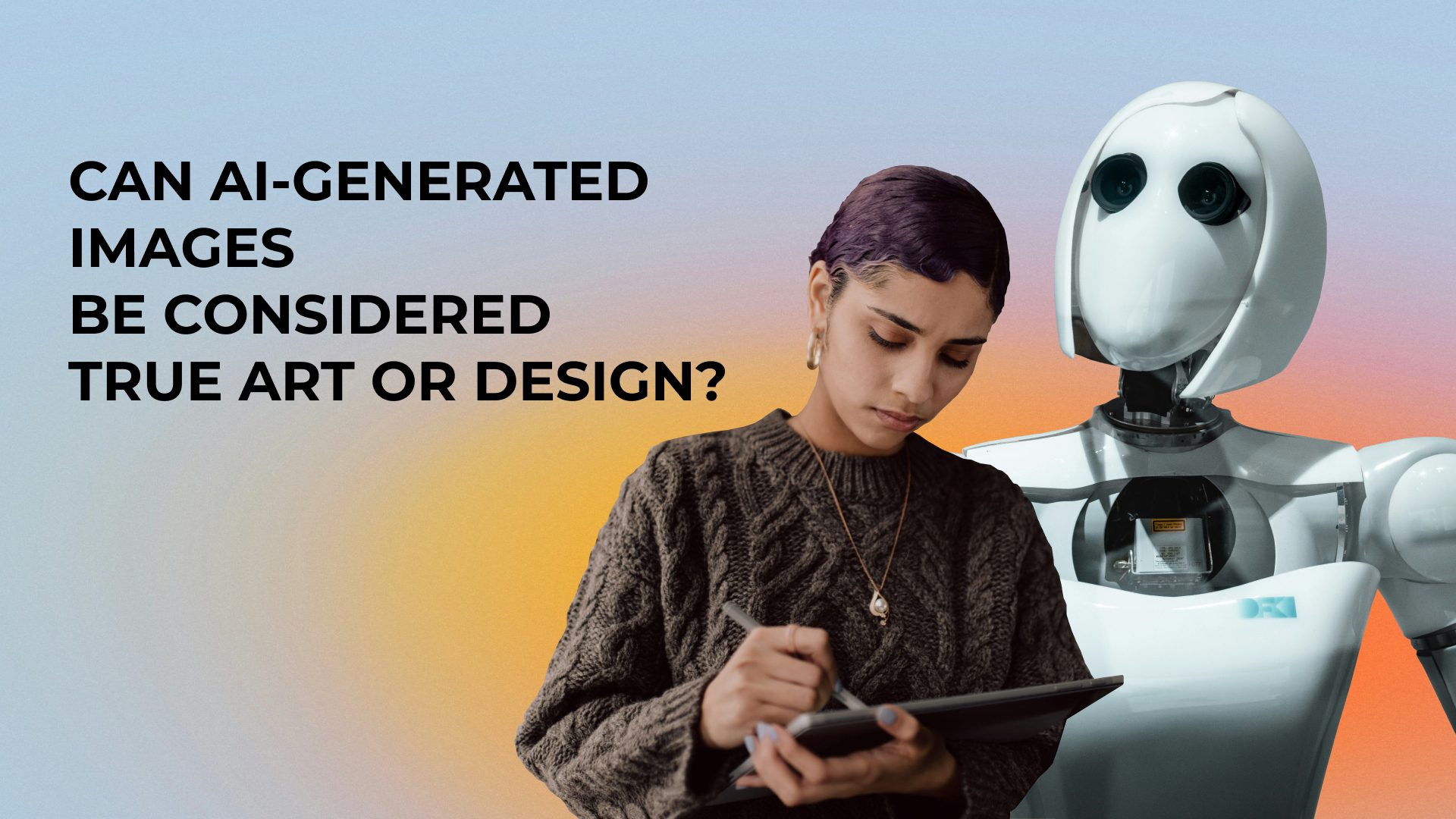Art is something that’s been around since the very first caveman decided to scratch a stone with a piece of charcoal. By definition, it’s a way of expressing yourself, sharing your feelings, ideas and opinions with the world around you. Considering this, one might say art requires an individual behind it. And here comes the elephant in the room, whose name is Artificial Intelligence (AI).
The future is here, so there’s no need to hire an actual artist who will visualize your wildest designs for money: AI can generate a jaw-dropping experimental garage rock album cover or make you look like a Simpsons character in a matter of minutes. AI’s ability to produce art opens up exciting possibilities, making creative visual expression more accessible to those without traditional artistic skills. This technology can enhance productivity, offering new tools for artists to explore their craft in ways previously unimaginable. However, the question remains: is AI art really art? Is machine truly effective in substituting people in that industry, and can we consider this way of art ethically correct?

Understanding AI-Generated Art
AI image generators such as OpenAI’s Dall-E 2, Midjourney, and Craiyon have recently stirred up a wave of concern among digital artists. Why? Let’s think… how does AI-generated art work? At its core, the AI systems analyze vast datasets of existing artwork, learn patterns, styles, and other prominent features to generate new pieces autonomously. As the AI model trains on the dataset, it identifies and internalizes the motifs and visual elements present in the public artworks.
Some may call it cheating and stealing as the services that generate imagery “borrow” and “learn” from other people’s styles and ideas. But let’s think about how actual humans learn art — through observation, inspiration and training. Nowadays it’s almost impossible to create something genuinely unique. Tens of thousands of years have passed since that first original caveman painting, so let’s face the fact that new ideas are usually a compilation of our previous experiences and inspirations. Just as AI systems analyze datasets of artwork to learn, human artists draw inspiration from the works of predecessors and contemporaries alike.
But don’t throw in the towel too soon! Let’s explore the AI vs human debate more thoroughly.

AI Art vs Human Art
Are those equally good? It’s a real head-scratcher that gets to the core of what makes art, well, art. Can something cooked up by a machine really capture the essence of human emotion and experience?
Some disagree, claiming AI art lacks that special spark of the human spirit. Back in 2016, Hayao Miyazaki called it “an insult to life itself.” Roger Spitz, an international bestselling author, in his book The Definitive Guide to Thriving on Disruption states that “with AI drawing art, creating music, and writing, human creativity is being challenged. Artists, musicians, composers, and writers are all experiencing upheaval which could match that of a factory becoming automated.”
Others view it as a way of collaboration between humans and machines, which can double the quality of the outcomes. Bill Gates once mentioned that “AI can be our friend,” and Microsoft CEO Satya Nadella believes AI will boost human abilities rather than replace them.
We humans have something that AI severely lacks — the power of imagination. AI might be able to piece together quite a lovely picture, but try to ask for something a little more customized, and you’ll most probably get let down. The truth is that AI is limited by the amount of training data it can process. Doesn’t look like it will ever match the human capacity for inspiration to produce something original. We put some soul behind our works, and that’s the reason why we will always prevail.
While AI can piece together a visually appealing picture, it often falls short when asked for something more customized or deeply personal. AI’s creativity is limited by the scope of its training data and lacks the human capacity for inspiration and emotional depth. Human creativity is driven by a complex interplay of emotions, experiences, and individual perspectives, something AI cannot replicate. This intrinsic human element ensures that while AI can mimic and generate art, it cannot truly replace the creative spark that defines human artistry.

Moreover, AI-generated art is not perfect (not yet, at least). In most cases, it’s easy to spot the machine’s creations. Here’s some tips on how to tell if art is AI-generated:
- Digital footprint: trace the image’s history using Google Lens, for example. Can you find its author? If yes, ask one more question: is it legit? Even if it’s gone viral on Twitter, you can never be sure it’s genuine without trusted sources. Trust no one, they say.
- Your only flaw — you are flawless: if the picture in front of you is kinda too perfect, that’s a reason to doubt. An unnaturally symmetrical face with smooth, poreless skin that looks like plastic, lacks texture and is overall a bit off is usually what an AI-generated selfie would look like. Don’t forget to look out for extra limbs!
- Friendly fire alert: as well as AI creates images, it can also rat itself out. Such tools as Optic AI or Not, Hugging Face’s AI Detector, or Content at Scale will help you nose out an impostor. You only need to paste the image or its URL and wait for the AI’s verdict.
- Artifacts: this is the most visible evidence of an AI-generated product. A close examination can reveal some inconsistencies as AI is assembling its inventions from the original work of others. For instance, some weird shapes, adrift pixels or a six-finger hand are the telltale signs of AI.
The potential of AI graphic design comes with its challenges, but with approval software like Approval Studio, navigating through your designs becomes much easier. Our online proofing tool enables you to pinpoint artifacts inherent in AI artwork, ensuring the highest quality for your projects. With its capabilities to annotate PDFs, images, and more, users can swiftly identify and address any design issues directly via online collaboration within the platform. Curious to explore how our tools can assist in detecting these nuances? Sign up for a demo to learn more!
Is AI-generated art legal?
The legal issues surrounding AI-generated works revolve around copyright law and the concept of authorship. Copyright law dictates what creative expressions are copyrightable and who holds the copyright in those works. In most cases, the copyright belongs to the creators of the work, unless it was produced as a work for hire, in which case the employer usually owns the copyright.
And here is the problem with AI-generated art: who is its owner? The process of training AI algorithms often involves using copyrighted material, which can lead to copyright infringement. Furthermore, the level of human input required for copyright protection in AI-generated art is ambiguous. Does the creativity lie in the algorithm, the programmer who designed it, or the user who directed its use?

In some cases, the use of copyrighted material may be protected by the fair use doctrine, especially if the new work is “transformative,” meaning that it adds a new expression or meaning rather than being a pure copy. As Picasso once said, “good artists copy, great artists steal”.
It is often safer for commercial purposes to obtain licenses or permissions from copyright owners for works closely related to AI-generated content. This will help avoid potential legal issues. Ethically, using original works as the basis for AI-generated art without permission or acknowledgement can be seen as disrespectful and potentially exploitative. Transparency about AI training materials is crucial for ethical development, ensuring users understand any legal and ethical implications. Unauthorized distribution or monetization of AI-generated art based on copyrighted material could harm original creators’ economic interests by cutting their control over distribution and market value. Artists may have emotional attachments to their work, and seeing it repurposed without consent could be offensive to them.

In simple terms, the legal status of AI-generated art is still fuzzy, with challenges surrounding authorship, ethics and copyright eligibility. As technology continues to evolve and AI becomes more and more integrated into creative processes, the legal community grapples with defining copyright in the digital age. The only thing for sure is that the outcome of these discussions will undoubtedly shape the future of intellectual property rights and AI innovation.
How to use AI as a Graphic Designer
Rather than measuring the authenticity of AI and human art, many designers are harnessing AI as a tool to enhance their work. How will AI affect graphic design? Well, AI can analyze data, give compositional advice, generate photorealistic images from textual descriptions, provide inspiration and assist variously in the creative process. Integrating AI-generated design into your workflow can provide awesome illustrations and striking graphic elements. Furthermore, it streamlines tasks like layout design and color or font selection so that you can focus more on conceptualization itself, enriching the creative output and saving valuable time.
Using AI for graphic design, you can also experiment with what you already have: create captivating visual effects, turn low-quality images into high-resolution ones and enhance the overall aesthetic appeal of your content effortlessly. So, if you’re eager to embrace the technology, try out tools like OpenArt, Adobe FireFly and Sensei Generative AI in your creative marketing endeavors! Treating AI as a creative comrade can boost your productivity to a brand-new level. Don’t be afraid of the technology taming you — tame it instead!

Final Thoughts
In wrapping up the discussion on AI-generated images and their place in the art world, it’s clear that we’re still figuring out where they stand. Art has always been a human thing, born from our emotions, experiences, and wild imaginations. Some see AI art as cheating or stealing, while others argue it’s simply a modern twist on age-old artistic processes. But let’s not kid ourselves — it’s not quite the same as art made by human hands and hearts. While AI tools offer a treasure trove of shortcuts and creative boosts, they can’t quite replicate the human touch. But hey, who says they have to? By teaming up with AI, we can supercharge our creativity and dive into uncharted artistic waters. So, whether you’re a die-hard traditionalist or an AI enthusiast, one thing’s for sure: the art world just got a whole lot more interesting.

 TEAM SOLUTIONS
TEAM SOLUTIONS

 WORKFLOW SOLUTIONS
WORKFLOW SOLUTIONS

 REVIEW TOOL
REVIEW TOOL PROJECT MANAGEMENT
PROJECT MANAGEMENT TOOLS & INTEGRATIONS
TOOLS & INTEGRATIONS CLIENT INTERVIEWS
CLIENT INTERVIEWS







![660376[1] 660376[1]](https://approval.studio/wp-content/uploads/elementor/thumbs/6603761-qdggwcisb076f7x5giotppxq66kg87ehjuo5mdrd3y.png)

